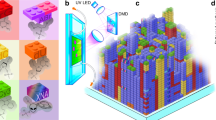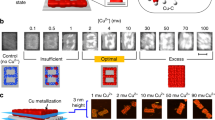Abstract
DNA nanotechnology offers unparalleled precision and programmability for the bottom-up organization of materials. This approach relies on pre-assembling a DNA scaffold, typically containing hundreds of different strands, and using it to position functional components. A particularly attractive strategy is to employ DNA nanostructures not as permanent scaffolds, but as transient, reusable templates to transfer essential information to other materials. To our knowledge, this approach, akin to top-down lithography, has not been examined. Here we report a molecular printing strategy that chemically transfers a discrete pattern of DNA strands from a three-dimensional DNA structure to a gold nanoparticle. We show that the particles inherit the DNA sequence configuration encoded in the parent template with high fidelity. This provides control over the number of DNA strands and their relative placement, directionality and sequence asymmetry. Importantly, the nanoparticles produced exhibit the site-specific addressability of DNA nanostructures, and are promising components for energy, information and biomedical applications.
This is a preview of subscription content, access via your institution
Access options
Subscribe to this journal
Receive 12 print issues and online access
$259.00 per year
only $21.58 per issue
Buy this article
- Purchase on Springer Link
- Instant access to full article PDF
Prices may be subject to local taxes which are calculated during checkout






Similar content being viewed by others
References
Mirkin, C. A., Letsinger, R. L., Mucic, R. C. & Storhoff, J. J. A DNA-based method for rationally assembling nanoparticles into macroscopic materials. Nature 382, 607–609 (1996).
Alivisatos, A. P. et al. Organization of ‘nanocrystal molecules’ using DNA. Nature 382, 609–611 (1996).
Tan, S. J., Campolongo, M. J., Luo, D. & Cheng, W. Building plasmonic nanostructures with DNA. Nature Nanotechnol. 6, 268–276 (2011).
Barrow, S. J., Funston, A. M., Wei, X. & Mulvaney, P. DNA-directed self-assembly and optical properties of discrete 1D, 2D and 3D plasmonic structures. Nano Today 8, 138–167 (2013).
Elghanian, R., Storhoff, J. J., Mucic, R. C., Letsinger, R. L. & Mirkin, C. A. Selective colorimetric detection of polynucleotides based on the distance-dependent optical properties of gold nanoparticles. Science 277, 1078–1081 (1997).
Park, S. Y. et al. DNA-programmable nanoparticle crystallization. Nature 451, 553–556 (2008).
Nykypanchuk, D., Maye, M. M., van der Lelie, D. & Gang, O. DNA-guided crystallization of colloidal nanoparticles. Nature 451, 549–552 (2008).
Maye, M. M., Kumara, M. T., Nykypanchuk, D., Sherman, W. B. & Gang, O. Switching binary states of nanoparticle superlattices and dimer clusters by DNA strands. Nature Nanotechnol. 5, 116–120 (2010).
Auyeung, E. et al. DNA-mediated nanoparticle crystallization into Wulff polyhedra. Nature 505, 73–77 (2014).
Macfarlane, R. J., O'Brien, M. N., Petrosko, S. H. & Mirkin, C. A. Nucleic acid-modified nanostructures as programmable atom equivalents: forging a new ‘Table of Elements’. Angew. Chem. Int. Ed. 52, 5688–5698 (2013).
Loweth, C. J., Caldwell, W. B., Peng, X., Alivisatos, A. P. & Schultz, P. G. DNA-based assembly of gold nanocrystals. Angew. Chem. Int. Ed. 38, 1808–1812 (1999).
Aldaye, F. A. & Sleiman, H. F. Sequential self-assembly of a DNA hexagon as a template for the organization of gold nanoparticles. Angew. Chem. Int. Ed. 45, 2204–2209 (2006).
Aldaye, F. A. & Sleiman, H. F. Dynamic DNA templates for discrete gold nanoparticle assemblies: control of geometry, modularity, write/erase and structural switching. J. Am. Chem. Soc. 129, 4130–4131 (2007).
Li, H., Park, S. H., Reif, J. H., LaBean, T. H. & Yan, H. DNA-templated self-assembly of protein and nanoparticle linear arrays. J. Am. Chem. Soc. 126, 418–419 (2003).
Le, J. D. et al. DNA-templated self-assembly of metallic nanocomponent arrays on a surface. Nano Lett. 4, 2343–2347 (2004).
Zhang, J., Liu, Y., Ke, Y. & Yan, H. Periodic square-like gold nanoparticle arrays templated by self-assembled 2D DNA nanogrids on a surface. Nano Lett. 6, 248–251 (2006).
Sharma, J. et al. Control of self-assembly of DNA tubules through integration of gold nanoparticles. Science 323, 112–116 (2009).
Chen, W. et al. Nanoparticle superstructures made by polymerase chain reaction: collective interactions of nanoparticles and a new principle for chiral materials. Nano Lett. 9, 2153–2159 (2009).
Mastroianni, A. J., Claridge, S. A. & Alivisatos, A. P. Pyramidal and chiral groupings of gold nanocrystals assembled using DNA scaffolds. J. Am. Chem. Soc. 131, 8455–8459 (2009).
Lau, K. L., Hamblin, G. D. & Sleiman, H. F. Gold nanoparticle 3D-DNA building blocks: high purity preparation and use for modular access to nanoparticle assemblies. Small 10, 660–666 (2014).
Ding, B. et al. Gold nanoparticle self-similar chain structure organized by DNA origami. J. Am. Chem. Soc. 132, 3248–3249 (2010).
Shen, X. et al. Rolling up gold nanoparticle-dressed DNA origami into three-dimensional plasmonic chiral nanostructures. J. Am. Chem. Soc. 134, 146–149 (2011).
Pal, S. et al. DNA directed self-assembly of anisotropic plasmonic nanostructures. J. Am. Chem. Soc. 133, 17606–17609 (2011).
Kuzyk, A. et al. DNA-based self-assembly of chiral plasmonic nanostructures with tailored optical response. Nature 483, 311–314 (2012).
Shen, X. et al. Three-dimensional plasmonic chiral tetramers assembled by DNA origami. Nano Lett. 13, 2128–2133 (2013).
Surwade, S. P. et al. Nanoscale growth and patterning of inorganic oxides using DNA nanostructure templates. J. Am. Chem. Soc. 135, 6778–6781 (2013).
Halverson, J. D. & Tkachenko, A. V. DNA-programmed mesoscopic architecture. Phys. Rev. E 87, 062310 (2013).
Kim, J.-W. & Deaton, R. Molecular self-assembly of multifunctional nanoparticle composites with arbitrary shapes and functions: challenges and strategies. Part. Part. Syst. Char. 30, 117–132 (2013).
Zhang, T., Yang, Z. & Liu, D. DNA discrete modified gold nanoparticles. Nanoscale 3, 4015–4021 (2011).
Suzuki, K., Hosokawa, K. & Maeda, M. Controlling the number and positions of oligonucleotides on gold nanoparticle surfaces. J. Am. Chem. Soc. 131, 7518–7519 (2009).
Zhang, T. et al. DNA bimodified gold nanoparticles. Langmuir 28, 1966–1970 (2011).
Zhang, C., Ma, J., Yang, J., Liu, S. & Xu, J. Binding assistance triggering attachments of hairpin DNA onto gold nanoparticles. Anal. Chem. 85, 11973–11978 (2013).
Wang, Y. et al. Colloids with valence and specific directional bonding. Nature 491, 51–55 (2012).
Xu, X., Rosi, N. L., Wang, Y., Huo, F. & Mirkin, C. A. Asymmetric functionalization of gold nanoparticles with oligonucleotides. J. Am. Chem. Soc. 128, 9286–9287 (2006).
Maye, M. M., Nykypanchuk, D., Cuisinier, M., van der Lelie, D. & Gang, O. Stepwise surface encoding for high-throughput assembly of nanoclusters. Nature Mater. 8, 388–391 (2009).
Feng, L., Dreyfus, R., Sha, R., Seeman, N. C. & Chaikin, P. M. DNA patchy particles. Adv. Mater. 25, 2779–2783 (2013).
Xing, H. et al. DNA-directed assembly of asymmetric nanoclusters using Janus nanoparticles. ACS Nano 6, 802–809 (2011).
Kim, J.-W., Kim, J.-H. & Deaton, R. DNA-linked nanoparticle building blocks for programmable matter. Angew. Chem. Int. Ed. 50, 9185–9190 (2011).
Tan, L. H., Xing, H., Chen, H. & Lu, Y. Facile and efficient preparation of anisotropic DNA-functionalized gold nanoparticles and their regioselective assembly. J. Am. Chem. Soc. 135, 17675–17678 (2013).
Carneiro, K. M. M., Aldaye, F. A. & Sleiman, H. F. Long-range assembly of DNA into nanofibers and highly ordered networks using a block copolymer approach. J. Am. Chem. Soc. 132, 679–685 (2010).
Edwardson, T. G. W., Carneiro, K. M. M., McLaughlin, C. K., Serpell, C. J. & Sleiman, H. F. Site-specific positioning of dendritic alkyl chains on DNA cages enables their geometry-dependent self-assembly. Nature Chem. 5, 868–875 (2013).
Hurst, S. J., Lytton-Jean, A. K. R. & Mirkin, C. A. Maximizing DNA loading on a range of gold nanoparticle sizes. Anal. Chem. 78, 8313–8318 (2006).
Li, Z., Jin, R., Mirkin, C. A. & Letsinger, R. L. Multiple thiol-anchor capped DNA-gold nanoparticle conjugates. Nucleic Acids Res. 30, 1558–1562 (2002).
McLaughlin, C. K. et al. Three-dimensional organization of block copolymers on ‘DNA- minimal’ scaffolds. J. Am. Chem. Soc. 134, 4280–4286 (2012).
Serpell, C. J., Edwardson, T. G. W., Chidchob, P., Carneiro, K. M. M. & Sleiman, H. F. Precision polymers and 3D DNA nanostructures: emergent assemblies from new parameter space. J. Am. Chem. Soc. 136, 15767–15774 (2014).
Huo, F., Lytton-Jean, A. K. R. & Mirkin, C. A. Asymmetric functionalization of nanoparticles based on thermally addressable DNA interconnects. Adv. Mater. 18, 2304–2306 (2006).
Reineck, P. et al. Distance and wavelength dependent quenching of molecular fluorescence by Au@SiO2. Core–shell nanoparticles. ACS Nano 7, 6636–6648 (2013).
De, M., Ghosh, P. S. & Rotello, V. M. Applications of nanoparticles in biology. Adv. Mater. 20, 4225–4241 (2008).
Mao, C., LaBean, T. H., Reif, J. H. & Seeman, N. C. Logical computation using algorithmic self-assembly of DNA triple-crossover molecules. Nature 407, 493–496 (2000).
Rothemund, P. W. K., Papadakis, N. & Winfree, E. Algorithmic self-assembly of DNA Sierpinski triangles. PLoS Biol. 2, e424 (2004).
Qian, L. & Winfree, E. Scaling up digital circuit computation with DNA strand displacement cascades. Science 332, 1196–1201 (2011).
Nikitin, M. P., Shipunova, V. O., Deyev, S. M. & Nikitin, P. I. Biocomputing based on particle disassembly. Nature Nanotechnol. 9, 716–722 (2014).
Lee, J. H., Yigit, M. V., Mazumdar, D. & Lu, Y. Molecular diagnostic and drug delivery agents based on aptamer-nanomaterial conjugates. Adv. Drug Delivery Rev. 62, 592–605 (2010).
Mallikaratchy, P. R. et al. A multivalent DNA aptamer specific for the B-cell receptor on human lymphoma and leukemia. Nucleic Acids Res. 39, 2458–2469 (2011).
Rosi, N. L. et al. Oligonucleotide-modified gold nanoparticles for intracellular gene regulation. Science 312, 1027–1030 (2006).
Acknowledgements
The authors acknowledge the Natural Sciences and Engineering Research Council of Canada (NSERC), the Canada Foundation for Innovation, the Centre for Self-Assembled Chemical Structures and the Canada Research Chairs Program for financial support. T.G.W.E. thanks the Canadian Institutes of Health Research for a Drug Development Training Program scholarship. D.B. thanks the NSERC for a Bionano scholarship and C.J.S. thanks the NSERC for a Banting Postdoctoral Fellowship. H.F.S. is a Cottrell Scholar of the Research Corporation.
Author information
Authors and Affiliations
Contributions
H.F.S. and T.G.W.E. designed the project. T.G.W.E. primarily contributed to the production of experimental results. K.L.L. carried out the synthesis of gold nanoparticles, TEM analysis, preparation of patterned AuNPs for the fluorescence studies and aided in data interpretation. D.B. carried out all the DLS experiments. C.J.S. synthesized the clip strands TC3-AB, PC4-AB and PC5-AB. All the authors have agreed to all the content of the manuscript.
Corresponding author
Ethics declarations
Competing interests
The authors declare no competing financial interests.
Supplementary information
Supplementary information
Supplementary information (PDF 6988 kb)
Rights and permissions
About this article
Cite this article
Edwardson, T., Lau, K., Bousmail, D. et al. Transfer of molecular recognition information from DNA nanostructures to gold nanoparticles. Nature Chem 8, 162–170 (2016). https://doi.org/10.1038/nchem.2420
Received:
Accepted:
Published:
Issue Date:
DOI: https://doi.org/10.1038/nchem.2420
This article is cited by
-
Immobilization of azide-functionalized proteins to micro- and nanoparticles directly from cell lysate
Microchimica Acta (2024)
-
Preparation, applications, and challenges of functional DNA nanomaterials
Nano Research (2023)
-
The biological applications of DNA nanomaterials: current challenges and future directions
Signal Transduction and Targeted Therapy (2021)
-
Flexible synthesis of high-purity plasmonic assemblies
Nano Research (2021)
-
Valence-programmable nanoparticle architectures
Nature Communications (2020)



